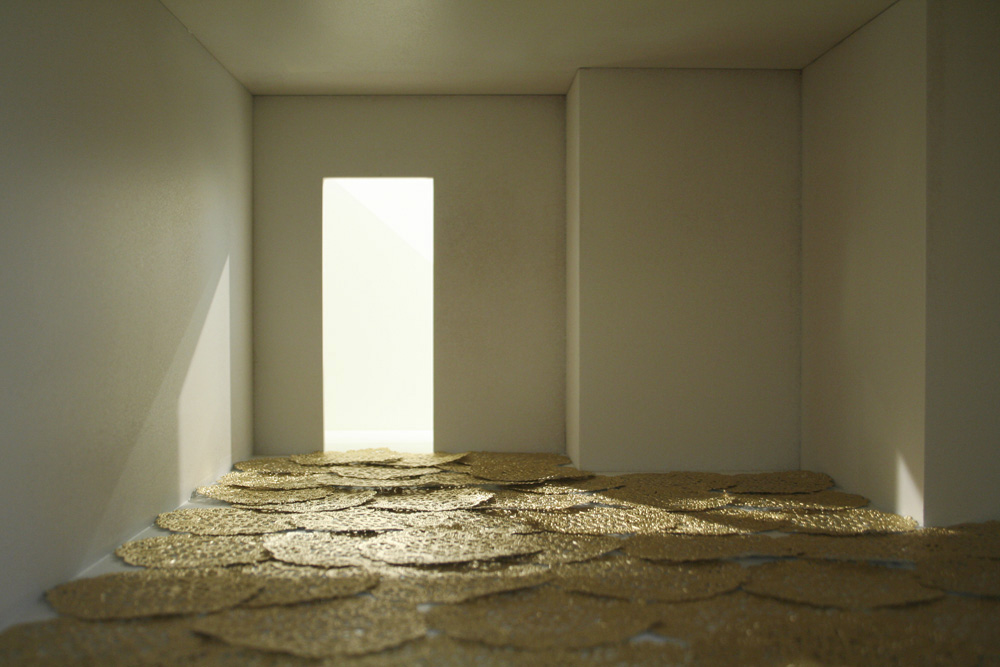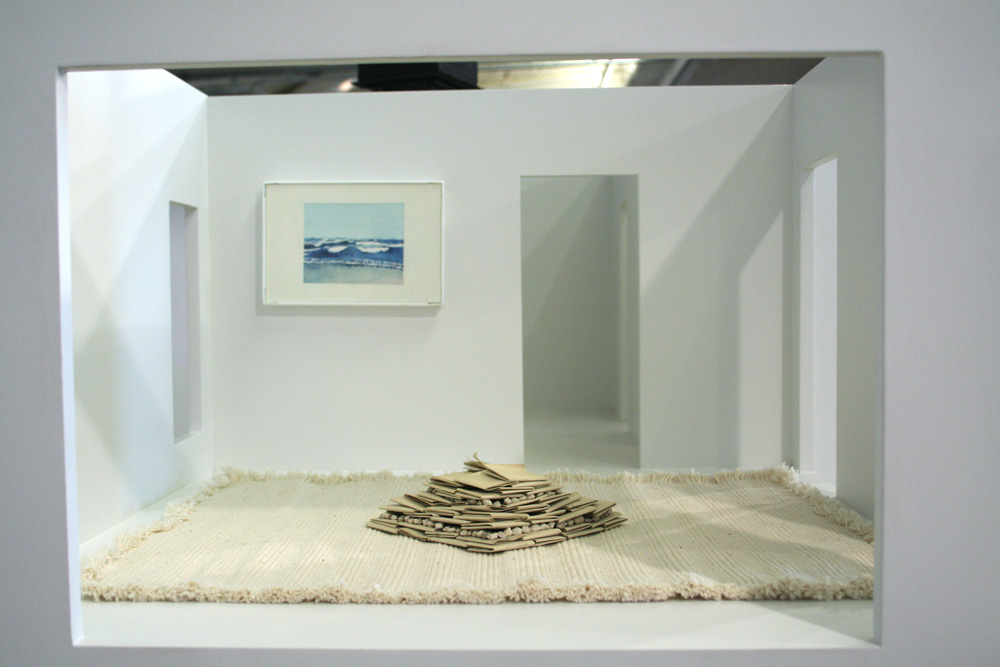




Passengers
CCA Wattis Institute of Contemporary Arts
San Francisco, CA
December 05, 2007 to January 05, 2008
Link ->
The Los Angeles-based artist Shana Lutker creates conceptual artworks that can be read as a form of psychoanalysis. She sets up small tests and experiments that occupy the same territory as classic Freud—the unconscious, the uncanny, Oedipal myths, desire, and belief—but paradoxically reveal very little of the artist. House #2 with Art That I Dreamt That I Made and Art That I Feel Like I Dreamt That I Made (Version #2, with Walls) (2004-7) is part of a series of works that Lutker first dreamed about and then created in her waking reality. They take a variety of forms, including drawings, small maquettes, and larger-scale sculptures; they have included a large ball of yellow lined paper, a pyramid of newspapers and rocks, and three sculptures of Oedipus. The series grew out of earlier works in which the artist investigated her dream world. Throughout 2003, for instance, Lutker recorded her dreams in as much detail as she could remember, and then every day in 2004 she created a one-page tabloid newssheet that headlined the storylines of these dreams (if she remembered none of them, then the paper remained blank).
Fragments of an Analysis of a Case of Art
by Jens Hoffmann
Reflecting her deep interest in Sigmund Freud's writings on dream analysis, in particular his book The Interpretation of Dreams (1899), the Los Angeles-based artist Shana Lutker has developed a large body of work that addresses this subject, utilizing a variety of media and a range of points of view.
All of Lutker's works are meticulously executed and carry numerous references to art history and popular culture. She most often presents her pieces in large, multipart installations that incorporate maquettes and models, and her display devices—small fiberboard walls, tables, plinths, and floor coverings—are always integral to the work. Her artworks often have a bleached, washed-out aesthetic and at first glance might appear fairly minimal, or even distant and dreamlike, while in fact they are quite elaborate and playful, with vividly surreal elements.
Lutker injects a surreal manipulation of scale, for instance, into House #2 with Art That I Dreamt That I Made and Art That I Feel Like I Dreamt That I Made (Version #2, with Walls) (2004-7) by placing small desk lights under an oversize table. This piece, which she presented in the group-show segment of the Wattis Institute's Passengers exhibition, is a model of a house on a large fiberboard table. The house is full of miniature artworks that the artist dreamed about but never actually created at full scale. The structure's design is, according to Lutker, based partly on her old family home as it has appeared in her dreams over the years, and partly on contemporary art galleries that she has visited in real life. A full-size book on the table next to the house contains records of her dreams from 2003. Many of these dreams describe the miniature artworks.
Other pieces inspired by dream analysis and psychoanalytic practice include Freuds (2003-5), a series of drawings portraying Freud; Blot Stack (2005), abstract drawings inspired by the Rorschach test; and Dream Book, 2003 (2004), a newspaperlike dream log. In its design, Dream Book, 2003 resembles the New York Times, the leading paper from the city where Lutker was born; in scale it recalls the Los Angeles Times, the paper from the city where she now resides. Its "articles" are records of the artist's dreams, and the headlines mimic those of actual newspapers.
While much of Lutker's oeuvre is interconnected—she often bases new works on previous ones, or integrates smaller pieces into larger installations—her solo exhibition at the Wattis Institute marks the beginning of a new series that moves away from dream interpretation. Yet it stays within an arm's length of her previous subjects by looking at yet another issue that Freud discussed extensively: the nature of civilization.
This exhibition, titled Erroneously Carried Out Actions (2007), juxtaposes representations of desire and time through a number of interconnected works. On one wall, visitors encounter a group of photographs of pig figurines. The artist made the figurines, basing them on existing miniature collectible pigs, and then photographed them in single portraits, in pairs, and in groups. Opposite the pigs is a large clock, also made by the artist. It is very minimal and industrial in appearance, and it ticks loudly. In the center of the gallery is a table with a book that contains an archive of "missed connections" from San Francisco's Craigslist. These short paragraphs are written by people who saw each other somewhere but missed the chance to meet, and now want to find each other again. Some of the entries seem full of desire, courage, and romance, but as a whole, one after another, they ultimately come across as sad, desperate, or just banal. The pigs allude to another kind of emptiness, which comes as a result of the human drive to consume things until they become meaningless—valuable only as additional accumulated possessions. Why do people collect these pigs? Why are they made with humanlike features? What is their function other than to fill emotional and physical space? The clock directs our attention back to the realm of the technological and the functional, as well as the alienating but inevitable fact that time and its measurement are in many respects the foundation of modern industrial civilization.
Like her dream works, these pieces come very close to clichés or kitsch, but they sidestep that potential pitfall through Lutker's careful and laborious process of re-making, or translating, them and presenting them as formal studies. By recontextualizing familiar objects and clichés that are concurrently universal and specific, cultural and personal, empty and full, she stages a situation that speaks to archetypal anxieties such as desperation, guilt, frustration, regret, shame, and loneliness.